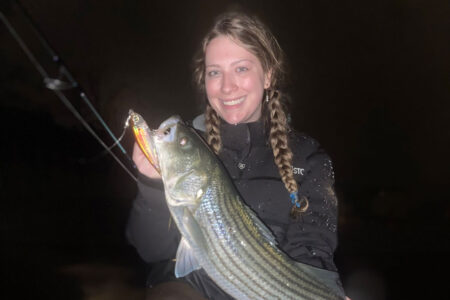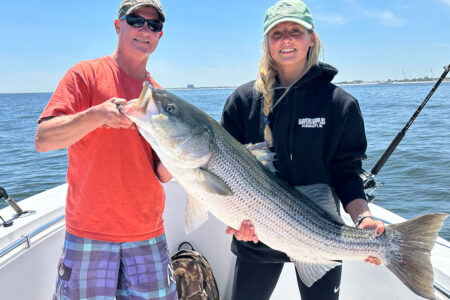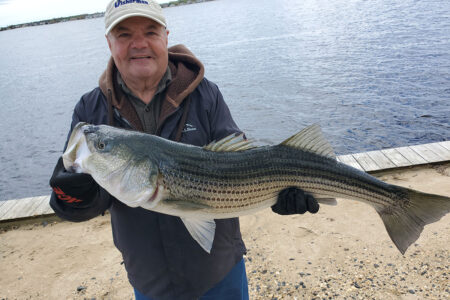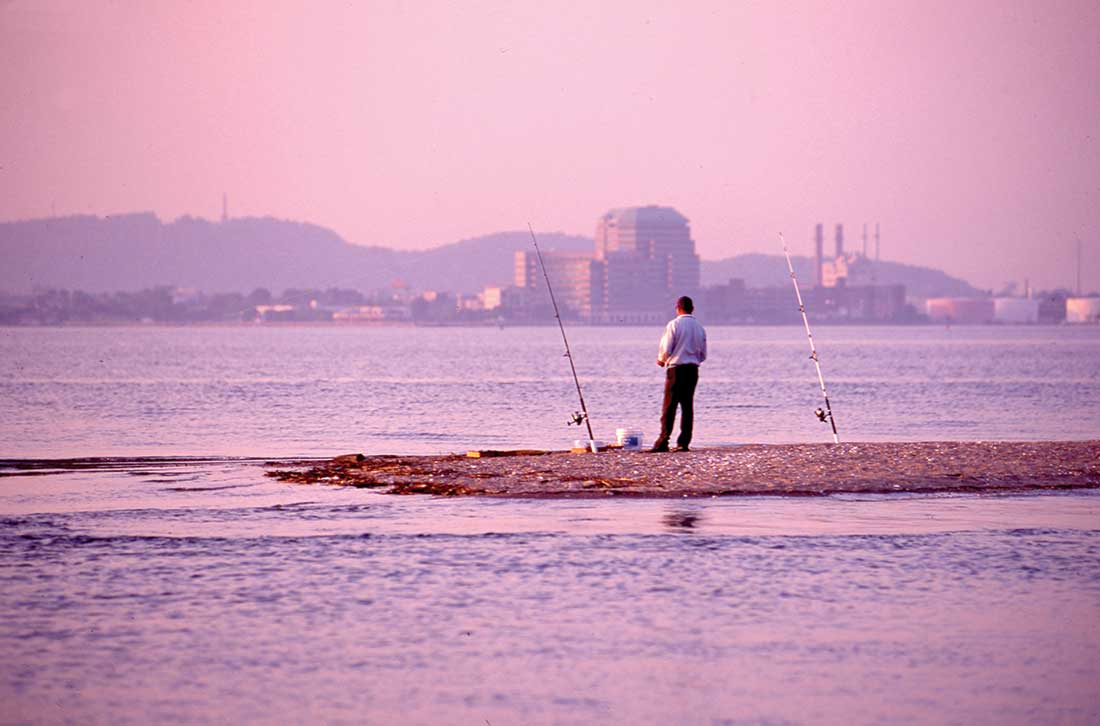
Tracking Long Island Sound’s early-season stripers from west to east both from shore and by boat.
The timing of Long Island Sound’s annual west-to-east spring striped bass migration begins as early as late April—especially after our record-breaking warm winter—but typically it slams into fast-forward by mid-May around the Norwalk area.
According to Captain Chris Elser (ct-fishing.com), a pro with over 40 years of experience fishing the western Sound, large schools of adult menhaden—the prey the bass pursue then—are more abundant at mid-Sound than in harbors early in May, but as the season progresses the forage moves into harbors like Norwalk, Bridgeport, and Black Rock.
The Best of the West
“The last several seasons,” said Elser, “I’ve seen fish arrive from the east in areas off Milford and Stratford about the same time others arrive from the west in the Norwalk area. The fish that race around the corner of Montauk after running the south shore of Long Island are loaded with sea lice, which will stay attached to stripers for several days until they fall off in the lower-salinity waters of Long Island Sound. These fish from the east are hit-and-miss and not as consistent as the traditional west-to-east migration. Therefore, I recommend starting your season in the Norwalk area.
“Boat anglers should target the Eaton’s Neck triangle, outlined by buoy 28C, 11B and the Obstruction or ‘E’ buoy off Eaton’s Neck, Long Island. This area has both deep and shallow structure to explore. In mid to late May, shore anglers can find stripers near harbor outflows like Calf Pasture Beach in Norwalk, Mill Pond in Westport and Sasco Beach in Southport; but soon afterwards, areas like Black Rock, Pleasure Beach, the mouth of the Housatonic River, and Milford Harbor will also produce fish into late May.”
Many of the bass near the Housatonic are exiting the river after wintering over, and these fish gradually descend as schools of river herring complete their spawning cycle and re-enter the Sound. These are a mix of large migratory bass and smaller resident river bass foraging on the 10-inch herring.
“I like fishing shallow mud flats with a 10-inch Big Occhi,” said Elser, “using no weight and snaking the large plastic lure through the surface film. This technique also works great for fish feeding on tight bunker schools near Stratford Shoals and Charles Island off Milford in mid spring.”
By mid-June, most of the Sound’s striper biomass is either staging in the western area or already passed through and is headed to eastern waters. This timeframe is when Elser looks for fish setting up near boulder fields, other structures, and anywhere you find bunker schools holding daily.
“When you find quality and numbers of stripers later in June,” advises Elser, “you should keep it to yourself because those fish tend to hold on that same structure much of the summer and often into autumn. This pattern was very evident during the late-spring 2019 season, where there were isolated areas of 20- to 30-plus-pound stripers on selective structure between Milford and Norwalk, and a few of those areas held quality stripers from late June to October.”
According to Elser, the key is to locate bait to find the bass during the spring fishery. Cover a lot of water until you find the forage and predators, which usually show by the second week of May and then peak near the end of June.
Many techniques are productive because the fish are hungry, so if you prefer to cast artificial lures think big when targeting fish near bunker schools but scale down your offering to imitate 3- to 4-inch sand eels when fishing near beaches and outflows. The ideal time to target beaches and outflows is about an hour or so into the falling tide as bait is being washed out into the Sound. Elser prefers the outgoing tide for many of the areas he targets by boat at mid-Sound mostly because of the west-to-east orientation of the structure. But he adds that there are very productive areas near Milford, Stratford, Bridgeport, and Norwalk on the incoming tide as well.
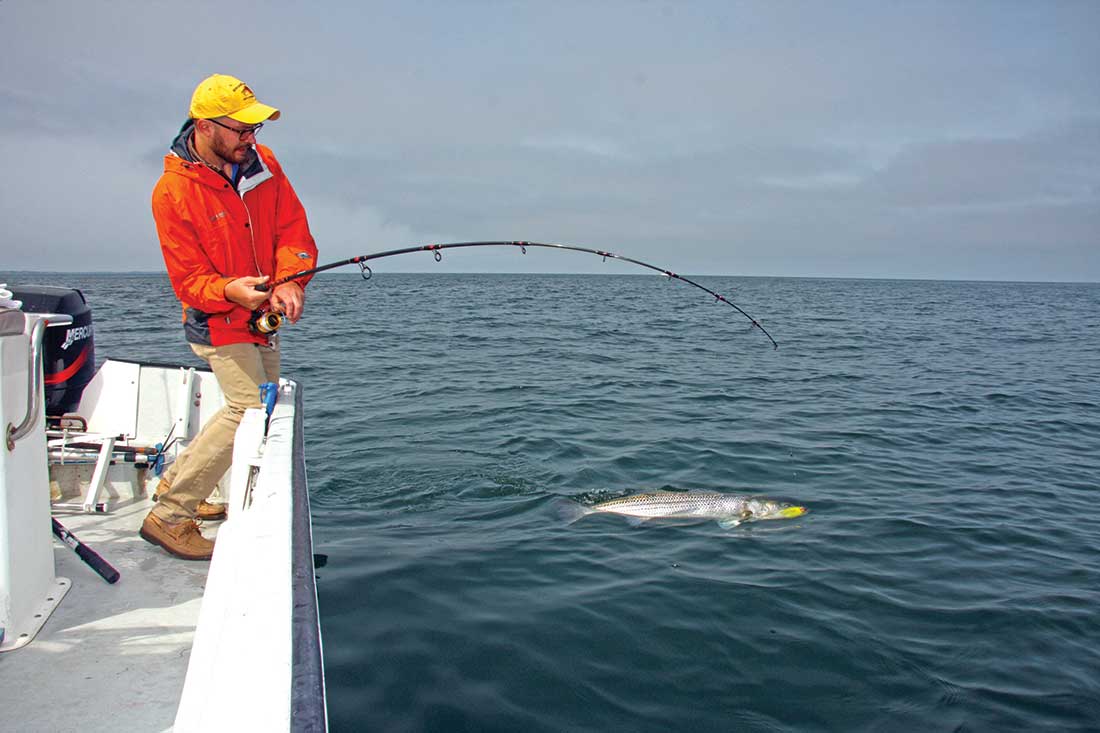
New Haven Harbor
Located on New Haven Harbor’s west side is the West Haven Sandbar, also called “Sandy Point.” This is an excellent striper location for early-season anglers without a boat. Bass are attracted to the area because of the confluence of the Quinnipiac, Mill, and West rivers, which dump baitfish into the harbor just above the sandbar. New Haven Harbor is known for both its schoolie and trophy stripers. The 75-pound, 6-ounce previous state record was caught here in 1992 in May.
The sandbar juts into mid harbor from the West Haven beach, and the entire bar is above water at low tide. However, although you can walk almost a half-mile out, be prepared for the flood tide with a pair of chest waders for the return trip. Expect rough, roiled water and loose seaweed with an east wind, which blows across the harbor into your face. The best times to fish the bar are the early morning and evening near a high tide. The water is very shallow at low tide.
Hammonasset Beach
Another good shot for bass for surf anglers is Hammonasset State Park in Madison, which is centrally located in Connecticut. Here, just a short distance from I-95, is a beautiful beach, camping, picnic area, nature trail and shoreline striper fishing. It’s an excellent place to bring the family for a few hours of fun while you fish.
Try casting off Hammonasset Point, which is only a short walk from Meigs Point parking lot. Head toward the mouth of the Hammonasset River where it meets the Sound and look for a large bouldered area. This spot holds bass as they wait for forage to be swept out of the river into open water. Be cautious of strong currents and slippery footing when wading this area. A car-top boat launch is located here, which is perfect for kayak anglers.
Another popular and productive fishing spot in the park is Meigs Point jetty, which is also located at the east end. Come prepared with heavy line and extra sinkers or lures. Large rock piles off the jetty attract and hold bass, but it’s also easy to lose some tackle here. Expect strong east/west currents off the jetty when the tide is at or near peak.
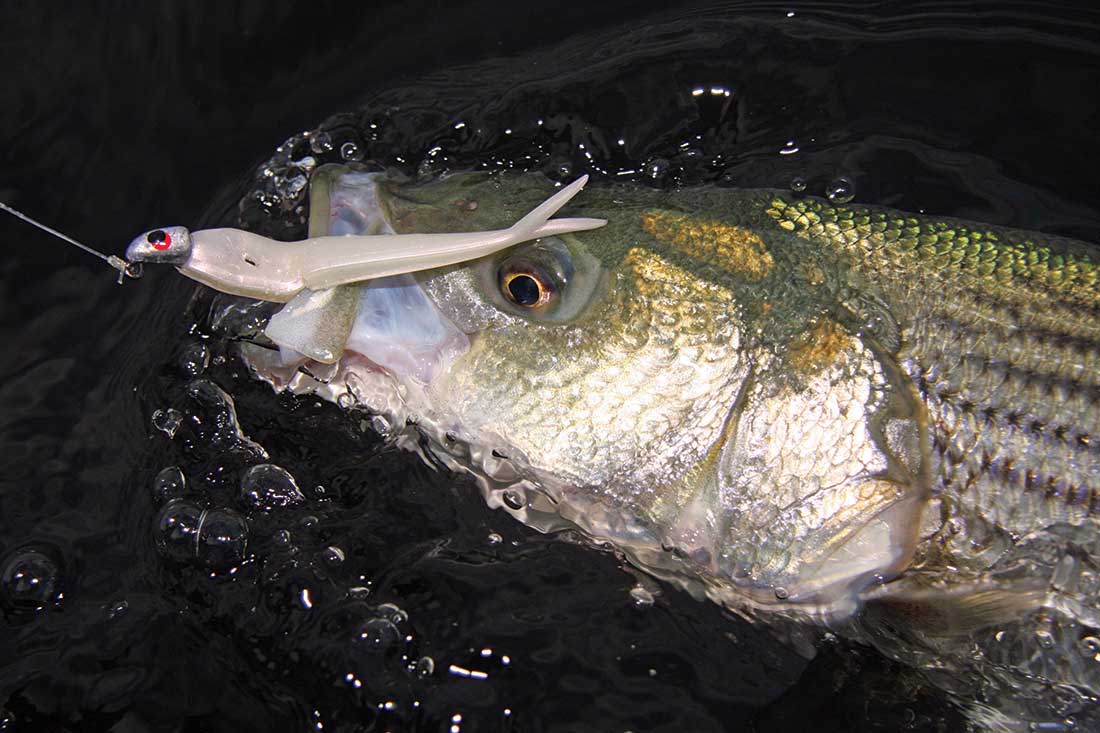
Connecticut River
Continuing east from Madison, next is the lower Connecticut River fronting Old Saybrook and Old Lyme. Starting at the confluence of the Back and Connecticut rivers is the area called the “Wood Lot.” At the start of the ebb, position your boat in the transition zone here where the depth of the water abruptly changes from 10 to 4 feet. Cast towards the shallows and retrieve a lure across the drop-off with a twitching motion.
Drift with the current until you locate a pod of schoolie stripers. Most days the fish are in the shallows, but an occasional cast to the deep side often finds bass as well. Sometimes fish are on the edge for nearly a quarter mile.
When the ebb is nearly finished and the Wood Lot bite wanes, motor farther south to Gibraltar Rocks, which are three large, clearly-defined boulder fields. This is a great spot to anchor, but be wary of subsurface, propeller-eating rocks. Cast up or across current and retrieve just fast enough to keep the lure from hanging bottom. Many schoolie bass and big hickory shad await prey in the slower, deeper water.
Still farther south and just east of buoy 8 is Sodom Rocks, which is another perennial schoolie hotspot. Griswold Piers, denoted with three small rips, and the Saybrook Breakwater, can also provide great action in this area.
As the current begins to slow, work back upriver towards the Wood Lot. Begin by fishing the Great Island shore just north of “Poverty Point,” this time in the shallow 3-foot water close to land. By staying with the fish, you may eventually work your way past the rocks that mark the entrance to the Back River and to the Lieutenant River mouth.
The lower Connecticut River action starts as early as late April and lasts into June, but its onset and success is dictated by snowmelt runoff—and therefore muddy water—from up north. Always check in with local tackle shops for updated reports on the hot spring bass bite.

